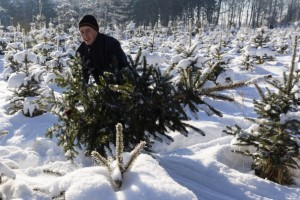Real vs Artificial Christmas Trees: An Easier Choice Than You Think

Photo by Joern Haufe/Getty Images
A man pulls out a Christmas tree he chose and cut down himself in a forest on December 8, 2012 in Fischbach, Germany.
Well, the debate is over. When it comes to picking a low-impact holiday tree, it turns out the choice between fake and artificial trees, call it a wash. A peer reviewed study released last year compared carbon footprints of artificial and natural trees. The findings showed that the difference in environmental impact between the two is negligible, with artificial trees having a slightly larger impact.
The study unpacked several consumer myths about holiday trees. The reality is that cutting down or buying a Christmas tree has less of an environmental impact than the daily impact of someone living for one day in the United States.
Also, a popular argument against artificial trees has been found false. Some have argued in the past that artificial trees have a bigger impact if they are made in China and shipped into the United States.
“The reality is that the long distance transport from China is pretty efficient,” says Laura Morrison, a Senior Consultant at PE International. She worked on the study and says that consumers should be more concerned about how far they drive personally to purchase their tree. Even if the tree has been shipped in from another state, it’s the personal drive home that significantly increases the carbon output.
“At the end of the day, truck transport is still much more efficient than driving your car,” Morrison says.
Another Christmas behavior that can make a significant difference is how the tree is decorated. The use of tree lights has a larger impact than the tree itself.
“From an environmental perspective, the use of LED lights is a low-hanging fruit that’s very easy for people,” says Morrison. She says changing the tree lights is a good way to lessen a holiday carbon footprint. “Using lights on your tree has a pretty big impact compared to the production of the tree itself. One big way to save is to switch from incandescent to LED lights,” she says. LED lights have roughly one-sixth the impact of incandescent lights.
Morrison also added that consolidating shopping trips is another highly effective way to stay environmentally minded during the Christmas season. Trying to do as much shopping as possible in one car trip is a way to lessen CO2 emissions into the air, for a cleaner, less-wasteful Christmas.